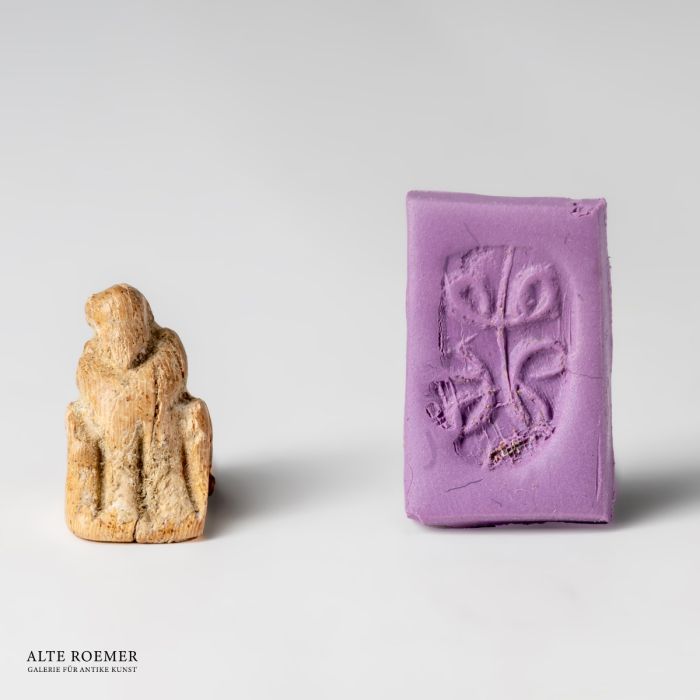Rare zoomorph Minoan seal
€6,500
available
Object number
AR3520A
| Object: |
Zoomorph Minoan seal
|
| Material: |
Ivory from the african elephant. Ivory is a very rare material for Bronze Age seals from the Aegean (0.5% of the seals from CMS Volume XI, see publication list). A trade license for the EU has been granted. Export outside the EU is not permitted. |
| Period: |
Early Minoan II to Middle Minoan IA, C. 2700 BC to 1900 BC, Aegaen Bronze Age. |
| Description: |
Minoan stamp seal in the form of a seated monkey with arms between its legs. The animal figure sits on the horseshoe-shaped seal surface. The stamp features volutes consisting of three C-shaped spirals with incurved ends, arranged with their backs to the center. A perforation along the transverse axis under the monkey's arms allowed for threading the seal. Seals from the Bronze Age of the Aegean are rare. An animal-shaped seal made of ivory, and in this condition, is an exceptional rarity. |
| Background: |
The Minoan seals of Crete offer a key to the Bronze Age world of the Minoans, whose culture flourished in the 3rd and 2nd millennia BC. These small, artfully engraved objects not only served as practical markings for goods and possessions, but also reflected religious ideas, social structures, and aesthetic principles. Glyptics developed into an independent art form on Crete. Animal depictions, cult scenes, and abstract symbols were carved into materials such as steatite, jasper, or agate. Compared to seals from Egypt or Mesopotamia, the Minoan pieces demonstrate remarkable originality, despite the close Mediterranean trade relations. For collectors and researchers, these seals are far more than artifacts. They are windows into a lost world whose secrets have aroused curiosity and the spirit of discovery since the time of Sir Arthur Evans. |
| Dimensions: |
Height 17,6mm. Width 11,4mm. Depth 18,9mm. The base 17,6mm x 11,3mm.
|
| Condition: |
Chips on the right side of the body, a piece of the left leg is chipped and missing. Some cracks and signs of aging on the surface. Overall, excellent condition for an ivory seal from this period.
|
| Provenance: |
Acquired by us in 2023 on the German art market. Previously in the Grumach family collection. The founder Dr. Ernst Grumach acquired the seal before 1968. Dr. Ernst Grumach (1902–1967) was a broadly positioned scholar specializing in classical philology, Egyptology, and linguistics. He placed an emphasis on the proto-writings of the Bronze Age Aegean. His collection of Cretan seals was created with a keen eye for significant pieces. It was studied by Ingo Pini, presumably in the 1960s during Dr. Grumach's lifetime, and later published with funding from the German Ministry of Education and Research. |
| Publications: |
Described in detail and illustrated in Ingo Pini, Corpus der minoischen und mykenischen Siegel (CMS), Band XI Kleinere europäische Sammlungen, p. 78, no. 69 (Akademie der Wissenschaften und der Literatur Mainz, 1988). Digitized in Arachne, the central object database of the German Archaeological Institute, Arachne-ID 1160098. Report from 2023 by state-certified expert Guenther Heckmann, which deals with the dating and material of this and another seal. |
| Literature: |
Relevant publications by or about Dr. Ernst Grumach, E. Grumach, Bibliographie der kretisch-mykenischen Epigraphik (Berlin and Munich, 1961). Festschrift for the 65. birthday of Ernst Grumach (posthum), W. C. Brice, Studien zur Geschichte und Epigraphik der frühen Aegaeis (Berlin, 1967). |
| Authenticity: |
We unconditionally guarantee the authenticity of every artefact, all items are subject to our lifetime return policy on authenticity.
|


